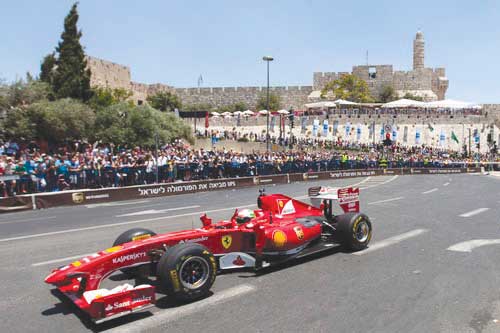.jpg)
There is something different about taking a ride from Shlomi Bakish. Not only can he get from Haifa to Tel Aviv in half the time, but passengers also don’t feel the road. The car accelerates without strain. Unlike many Israeli drivers, Bakish doesn’t express rage when a slower car cuts him off. He sees his opportunity and easily passes on the right. It’s as though he’s driving in a race.
For the past decade, talented Israeli drivers like Bakish were stranded in traffic by an unpopular law regulating motorsports. But new regulations approved in March 2011 by the Knesset’s Education, Culture and Sports Committee have opened doors for enthusiasts of Formula racing—which encompasses several forms of open-wheeled, single-seat racecar driving including Formula Renault, Formula One, Formula Two, Formula Three, and World Series by Renault—to get back in the driver’s seat. The Jewish state’s first Formula One road show, which took place in mid-June, attracted 100,000 spectators.
Formula Israel developers Boaz Meiri and Ofir Frank, instructors at the renowned Zig Zag driving school in France, and remarkably “driven” students form the unique Israeli motorsports team.
When the Israeli motorsports law was lifted, Meiri and Frank saw an opportunity not only to build Israel’s first professional racetrack in the Port of Eilat, but also to experiment, and to democratize the Formula racing establishment. They are striving to make Formula racing affordable and accessible to the Israeli public.
“Traditionally, you have to be very rich and well licensed to drive in the Formula,” Meiri tells JNS.org.
As racetrack construction began in Eilat, Meiri and Frank organized a new method for recruiting and training drivers. Their efforts have created a pioneer racing culture in Israel that is likely to inspire similar programs around the world.
“The idea is drivers driving,” Frank tells JNS.org. “We want to give enthusiasts who have the talent to race competitively but who don’t have the money to participate in the sport the rare opportunity to drive a real race car.”
Every summer, Israelis are now invited to submit applications to Israel’s Formula training program. For only 300 shekels, roughly $100, every applicant receives a special evaluation by Formula Renault professionals. Ultimately, a team of 30 drivers is selected for formal training.
In 2011, nearly 3,000 drivers tried out for the program. The selection process yielded a team of 20 men and 10 women. Because the mile-long racetrack in Eilat was not yet completed, the drivers were sent to France to receive hands-on instruction in preparation for Israel’s first Formula One competition.
Training at the Zig Zag school consists of grueling physical conditioning courses, as well as a regimen of computer simulator exercises. “A good driver needs to know how to push the car to the limit of traction without losing control,” Bakish tells JNS.org. “It’s a very thin line, and it takes time. You have to handle the car gently. If you are brutal, it will punish you.”
For Bakish, who participated in the pilot program and was ranked 3rd prior to the 2012 Eilat race, the opportunity to drive a Formula racecar was the fulfillment of a childhood dream.
“The car is very compact,” Bakish describes his first Formula Renault car. “Drivers lie down inside a narrow tunnel. You have to wear special shoes; otherwise your feet will get stuck on the pedals. The engine has an amazing sound, and the car can do 0-60 miles per hour in around 3.5 seconds. Top speed is near 240 kilometers per hour.”
Bakish’s recalls an exhilarating experience in the 2012 race.
“Driving on the track is intense,” he recalls. “You are claustrophobic, the safety belts are tight, and you can’t move anything but your head and hands. It’s very hot. The combination of helmet, racing suit, engine heat, no AC, hot Eilat weather and adrenalin makes your heart beat hard. You have to remain focused, push the car to the limit without losing control.”
Meiri and Frank are counting on the thrilling experiences reported by freshly trained drivers, like Bakish, to fuel enthusiasm for future motorsports events in Israel.
Already, the sport’s following is growing at a remarkable rate. Nearly 4,000 spectators—mostly tourists and families—attended last year’s race in Eilat, packing the stands.
The initial race in Eilat cost 6 million shekels ($1.7 million) to produce, but this was partly due to the high price of start-up construction and the need to purchase expensive licenses and insurance policies. Now the price has come down considerably, costing the organization only 2.5 million shekels to host the annual winter race.
“Last year we made a profit,” Meiri says. “Now we are more organized. After the first race, we also held a road show in Jerusalem. These events have strengthened the Formula culture in Israel and are encouraging more advertisers and sponsors to invest in Israeli racing.”
Meiri and Frank, who have worked out a five-year lease on the racetrack with Israel’s Ministry of Transportation, have ambitious plans. Currently, the racetrack in Eilat is used for part of the year as a parking lot for new cars shipped to Israel from the Far East. To attract international attention, Israel needs a larger, more permanent facility.
“We have a long-term goal of opening a medium, 3,000 meter-long track in Israel for courses and motorsport experiences,” Frank says. “In the future, we also want to be able to host teams from all over the world so that they can practice during the winter.”
Meiri says those driving Israel’s growth in the motorsports scene have “surprised all the skeptics with our professionalism.”
“Most importantly, our winning formula has changed the way fans interact with the sport,” he says.
By Jeffrey F. Barken/JNS.org









